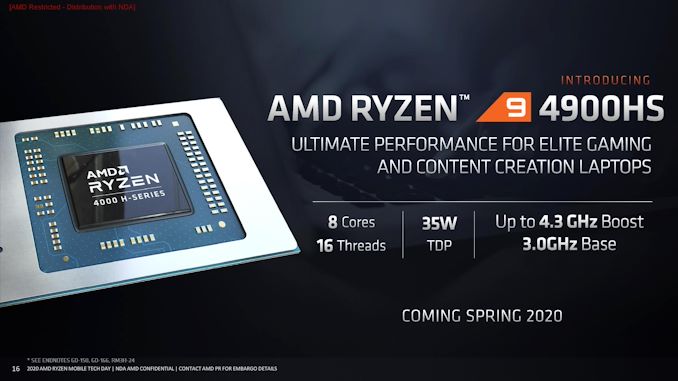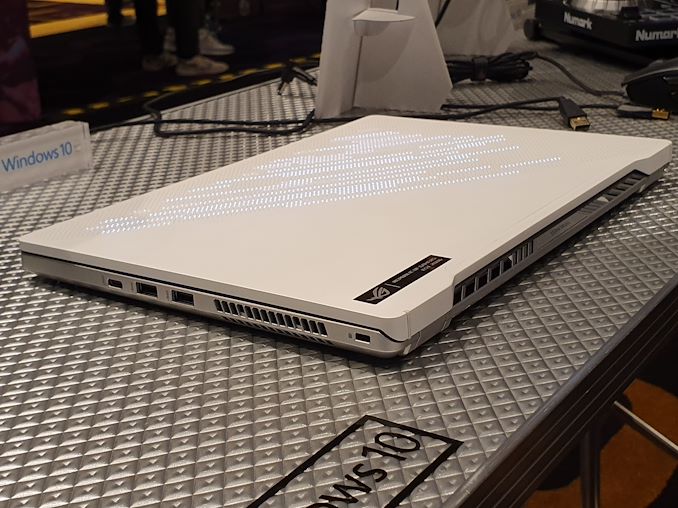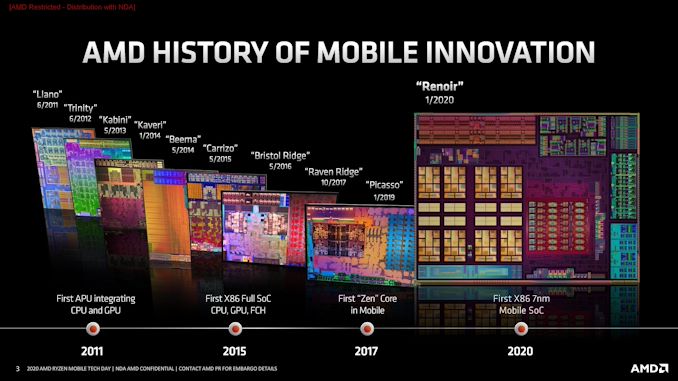AMD Announces Ryzen 9 4900H and 4900HS: The Halo 35 W and 45 W Mobile APUs
by Dr. Ian Cutress on March 16, 2020 9:00 AM EST- Posted in
- CPUs
- AMD
- APUs
- 35W
- 45W
- Ryzen Mobile
- Ryzen 9
- Ryzen 4000
- Ryzen 9 4900HS

As part of the disclosures on AMD’s Ryzen Mobile 4000 portfolio, the company is also lifting the lid on perhaps one of the worst kept secrets in mobile computing: the new top-of-the-line Ryzen 9 4900H family. This family consists of two processors, the standard H model built for 45 W operation, and the HS model at 35 W. These parts will offer more frequency and more graphics performance than the rest of AMD’s offerings, and are the only APUs from AMD to carry the weight of the Ryzen 9 branding.
We saw from AMD’s first announcement of its Ryzen Mobile 4000 family back in January that it was eager to attack the notebook market with its Zen 2-based 7nm products, featuring up to 8 cores and an updated Vega graphics engine. With the Zen 2 cores being a resounding success on the desktop in chiplet form, the monolithic APU market is where AMD has to ride over previous barriers to performance and marketability, and the belief in the company is that it will do so through 2020 with a combination of high performance x86 products delivering ‘superior’ graphics performance all while achieving multiple design wins. In January we saw several of those design wins in the flesh, such as the ASUS Zephyrus G14, the only 14-inch laptop with both a H-class processor and a discrete GPU, as well as an array of thin and light designs all based on the U-series family.

ASUS Zephyrus G14, with Ryzen 7 4800HS
The Ryzen 9 offerings from AMD are meant to be designated the best of the best, and one of the announcements missing in January was a mobile-class Ryzen 9 processor. Despite the lack of AMD mentioning one, it was a number of AMD’s OEM partners that spoke out of turn, showcasing various notebook designs with labels such as ‘Up to AMD Ryzen 9’ on the packaging, indicating that we were set to see a Ryzen 9 product in the portfolio. The official announcement is today, with the Ryzen 9 4900H and the Ryzen 9 4900HS.
| AMD Ryzen Mobile 4000 APUs | |||||||
| AnandTech | Cores Threads |
Base Freq |
Turbo Freq |
L2 | L3 | GPU CUs GPU Freq |
TDP |
| H-Series | |||||||
| Ryzen 9 4900H | 8 / 16 | 3.3 GHz | 4.4 GHz | 4 MB | 8 MB | 8 / 1750 MHz | 45 W |
| Ryzen 9 4900HS | 8 / 16 | 3.0 GHz | 4.3 GHz | 4 MB | 8 MB | 8 / 1750 MHz | 35 W |
| Ryzen 7 4800H | 8 / 16 | 2.9 GHz | 4.2 GHz | 4 MB | 8 MB | 7 / 1600 MHz | 45 W |
| Ryzen 7 4800HS | 8 / 16 | 2.9 GHz | 4.2 GHz | 4 MB | 8 MB | 7 / 1600 MHz | 35 W |
| Ryzen 5 4600H | 6 / 12 | 3.0 GHz | 4.0 GHz | 3 MB | 8 MB | 6 / 1500 MHz | 45 W |
| Ryzen 5 4600HS | 6 / 12 | 3.0 GHz | 4.0 GHz | 3 MB | 8 MB | 6 / 1500 MHz | 35 W |
| U-Series | |||||||
| Ryzen 7 4800U | 8 / 16 | 1.8 GHz | 4.2 GHz | 4 MB | 8 MB | 8 / 1750 MHz | 15 W |
| Ryzen 7 4700U | 8 / 8 | 2.0 GHz | 4.1 GHz | 4 MB | 8 MB | 7 / 1600 MHz | 15 W |
| Ryzen 5 4600U | 6 / 12 | 2.1 GHz | 4.0 GHz | 3 MB | 8 MB | 6 / 1500 MHz | 15 W |
| Ryzen 5 4500U | 6 / 6 | 2.3 GHz | 4.0 GHz | 3 MB | 8 MB | 6 / 1500 MHz | 15 W |
| Ryzen 3 4300U | 4 / 4 | 2.7 GHz | 3.7 GHz | 2 MB | 4 MB | 5 / 1400 MHz | 15 W |
AMD’s H processors have a TDP of 45 W, indicating that at sustained load (with enough temperature headroom), the CPU will run at 45 W, and try and take the best frequency it can at 45 W.
The HS processors are a bit different to the H processors. They mostly have the same frequencies (except the Ryzen 9), but are labelled as 35 W in the default configuration. That means it will still try and aim for the best frequency, but the sustained power consumption is only 35 W. Not everyone can buy the HS processor – AMD reserves these parts for OEM partners that it works in tandem with to give the best experience. The first HS system into the market will be that ASUS Zephyrus G14, and that system will have a short exclusivity on the Ryzen 7 version parts.
Note that the normal H processors can also be set at 35 W by the OEM, but that won’t make them a HS processor – the S means that AMD has validated the design, and AMD has the units in house and pre-tests any updates to the notebooks before the updates get released. This comes from AMD’s two Continuous Validation Labs, one in Austin and one in Shanghai. We (the press) postulated that the ‘HS’ stands for ‘High School’, with these parts being targeted for the back-to-school designs. AMD corrected us, saying that the H is just the class, and the S stands for Special.
With regards the Ryzen 9 processors, AMD initially actually only gave us the specifications of the 4900HS, with the 4900H ‘to be disclosed'. This could have been for two reasons – firstly that the 4900HS might be the only model we’ll see, that AMD wants to keep it for those designs formed from collaboration with OEMs, or secondly that it’s a high enough binning of a chip that they want to dedicate the first batches to those collaborations. In the end, the day before this announcement, we discovered the details in the latest version of the slide decks. Nonetheless, the Ryzen 9 4900HS sits +100 MHz above the Ryzen 7 parts, with one extra compute unit and +150 MHz on the graphics frequency, and the Ryzen 9 4900H is +300 MHz on the base over the 4900HS, and +100 MHz on the turbo. All the parts are PCIe 3.0, for power reasons.
The Ryzen 9 4900H and Ryzen 9 4900HS are expected to hit the market in the Spring (Q2?) of 2020. Given the recent global situation, it might be out in China before it comes to the rest of the world.











37 Comments
View All Comments
Teckk - Monday, March 16, 2020 - link
Where are 45W IceLake and a WhateverNewLake?The graphics is clearly specified here, don't be that bad a troll.
Irata - Monday, March 16, 2020 - link
Wow, aiming for new lows I see. Even if you don‘t read the article and just look at the charts you can‘t possibly miss that these are APU.deksman2 - Monday, March 16, 2020 - link
You should really educate yourself better on Zen 2 mobile lineup.All Zen mobile APU's to date have had iGPs.
Zen 2 mobile is no different.
While it IS accurate that Zen 2 mobile uses Vega iGP, those iGPU cores have been enhanced. AMD specifically mentioned in previous slides 56% higher performance per core over previous iterations.
So, we're looking at about 30% bigger (or more) performance in this Vega iGP compared to the Zen1 and Zen+ mobile APU's (30% because AMD reduced the number of compute units in this iGP to keep everything in the same TDP properly - but its still a decent improvement).
sharath.naik - Monday, March 16, 2020 - link
the success of this will depend on their idle power usage. That has always been the reason for not doing well on laptops. nothing in the article points to it.PeachNCream - Monday, March 16, 2020 - link
AMD has previously discussed efforts intended to address power consumption with the new Ryzen processors, but we will have to wait until products trickle out to in order to get a feel for that aspect of new mobile CPUs. I'm certainly interested in seeing what AMD brings to the table because, you are right, with respect to idle usage, they are not currently competitive.csutcliff - Monday, March 16, 2020 - link
or as AMD put it themselves, intel CPUs are very good at doing nothing!0ldman79 - Monday, March 16, 2020 - link
It's more to it than that.My i5 6300HQ pulls around 2W while watching 1080P video. The idle power usage is essentially the baseline for low usage battery life.
Last gen of Ryzen mobile was about the same as my Sandy Bridge i7, 5W at idle, higher with *any* usage at all.
Compare that to an old Skylake (now nearly 5 years old) that runs 2W watching a video and barely half a watt at idle and the battery life differences are incredible.
Irata - Monday, March 16, 2020 - link
While idle power consumption is important, who buys a laptop because it‘s good at doing nothing?While low idle power consumption is certainly a good thing, power consumption when actually performing tasks is imho much more relevant.
drothgery - Monday, March 16, 2020 - link
Idle power consumption is pretty critical to long battery life; non-server CPUs spend quite a bit of cycles idling in most cases.eek2121 - Monday, March 16, 2020 - link
My laptop and desktop spend far more time at 0% usage vs 100% usage. Computing scenarios in general are bursty.